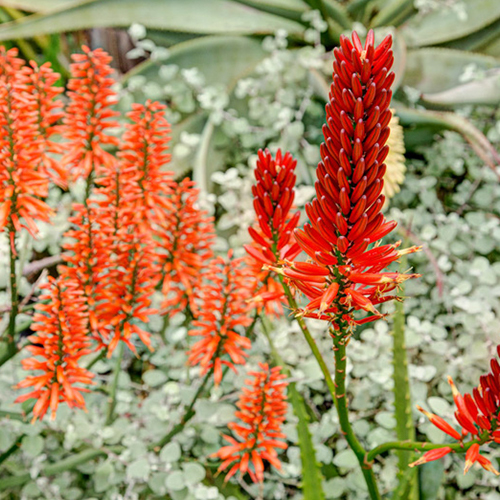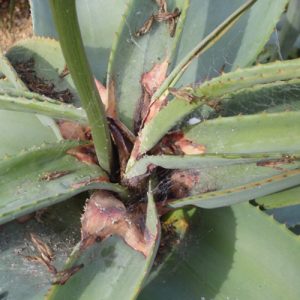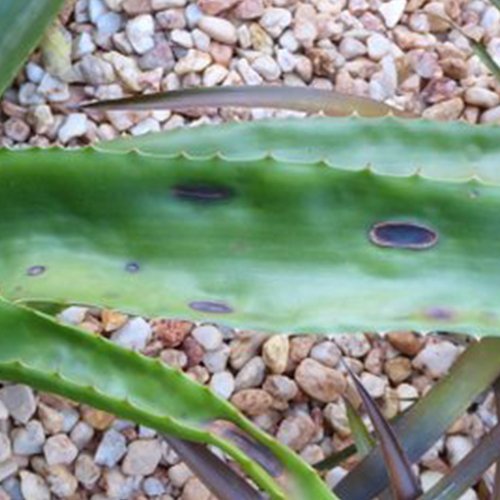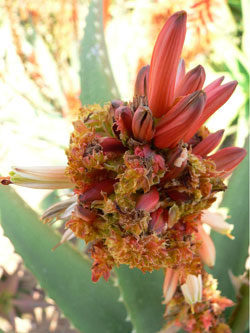
Pests and Diseases
In the world of living things (human or plant) there are always undesired nasties lurking and this includes in the world of aloes, which are generally tough plants relative to other garden plants.
However fortunately Australia is generally free of some of the really bad nasties affecting aloes in Africa and our quarantine regime hopes to keep it that way, preventing the illegal import of aloes into our island nation.
Aloe-Aloe cultivars are all derived from genetically superior plants with “hybrid vigor” they are generally stronger and much better able to cope with pests and disease than most pure aloe species.
However the best defence against disease is a healthy Aloe-Aloe receiving good sunlight, sufficient water and good nutrition.
Treatments of pests and diseases can be through the use of insecticides or by using more organic environmentally friendly solutions. We recognize the risks associated with insecticides and the risks certain insecticides introduce to other beneficial insects like bees and to the general health of the garden and the family. For this reason where possible we practice environmentally friendly solutions ourselves, but in a nursery production environment this is not always possible as we know from a lot of the fresh fruit and vegetables we purchase in the supermarkets.

Preventative treatments include ensuring spent flower material is removed and applying high pressure water to the plant rosette and stem.
However be aware if using insecticides that unlike most other plants, only insignificant amounts of even systemic insecticides are absorbed through aloe leaves. This makes pollen and nectar of aloe flowers safe for avifauna consumption, provided care is taken not to get sprays or powder directly onto the aloe flowers. If spraying is necessary we suggest that it be undertaken when there are the least number of flowers in the garden.
Aphids and Mealybugs
Aphids and mealybugs are the most common sap-sucking insects in Australian gardens. Aphids are soft bodied and pear shaped with a body size from 1mm up to 4mm and can be shades of green, pale yellow or even white. Mealybugs are about 3mm to 7mm long and are covered in whitish ‘mealy wax’
Aphids are amongst the most prominent and successful pests worldwide and in our experience are the greatest risk to aloes in Australia. They seem to the most active after winter cold has passed but sometimes even during mild winter weather. They will aim for the very centre of the aloe plant and often need very close examination to detect them. One of the best indicators of aphid activity is ants on an aloe. Ants and aphids have a symbiotic relationship with ants affording protection to mealy bugs in exchange for honeydew, the sticky substance they secrete. Ants can carry aphids from plant to plant. When they have been left unhindered for a few weeks, the aloe reacts by closing the centre leaves in an effort to protect the damaged tissue. This suits the baddies perfectly because it means more hiding place for them. If left untreated aphids can cause severe damage to the new growth (they puncture the plant), sometimes with rot setting in resulting in the loss of a plant
Regular inspection for aphids or mealybugs is important
There are a number of organic pesticides that are able to be used
Systemic garden insecticide sprays are most effective in controlling this pest
Be sure to pull the centre leaves apart where they seem to be stuck together, before applying insecticide.
It is also important to cut off infected and damaged leaves
Alternative treatments which are more environmentally friendly are possible and include:
-
Spraying with a high pressure of water from a garden hose
-
Wipe off aphids/mealy bugs with a sponge of soapy water
-
Spraying with neem oil
-
Spray with a cocktail of herbal oils


Black Leaf Spot

Black leaf spot may be caused by a variety of fungal or bacterial infections, and is more likely when plants are under stress due to excessive moisture or high temperatures combined with high humidity. Bad drainage, not enough sun and poor soil often make this worse.
A lack of nutrients can affect susceptibility. Spots are more likely to appear on older leaves. Some aloes have a genetic susceptibility, and often a few spots are unavoidable. This is no cause for concern, as it does not affect the plant’s health or flowering (they are a bit like a pimple on a human).
Usually with improving the soil (rich organic soil), allowing more sun and improving drainage, black spot will not appear on the new leaves. If the spots are really unsightly (e.g. covering more than 10% of the leaf surface) spraying with a fungicide (e.g. mancoseb) may be necessary to clean up the new growth but the old leaves will always carry the damage until they are removed.
White Scale
White scale looks grey and on close examination rows of white scale can be seen, these sap suckers are white in colour and are about 1mm to 2mm long. It starts with what looks like a coin sized spot of white dust. It will gradually cover more and more of the leaf upper and lower surface. Eventually this deprives the plant of sunlight to the extent that it can deteriorate and die. They are stationary insects that are easy to kill, but they tend to remain where they are, creating the impression that the insecticide has had no effect on them.
An environmentally acceptable treatment is to brush off the living insects with a toothbrush a strong jet of water. A solution of soapy water (some even suggest adding a little methylates spirits to the soapy water) or some suggest cooking oil can then be applied.
Alternatively a contact insecticide can be applied to kill the white scale (some believe that a preventative spraying with an insecticide may still be necessary even after the above environmentally treatment have been applied)
Eriophyid Mites (Gall mites)
Eriophyid mites can cause damage to plant leaves and/or flowers of many different plant species and have been increasingly seen in aloes across Australia in recent years. These mites are parasites and whilst they seldom kill plants, they do penetrate plant cells causing visible deformations and abnormalities in the form of unsightly galls on the leaves or crooked flower clusters. These galls look like abnormal tissue growths and can be different colours including yellow and red. It is important that remedial action be taken and that they are not left untreated as they can easily spread in the garden.
A contact insecticide will kill the mites on the surface of the plant but not those mites within the gall which are microscopic (unable to be seen) and have an ideal environment to live in as they are protected from predators and contact insecticides/miticides. For this reason it is recommended that the entire affected plant be destroyed by double bagging and disposing of properly- Do not leave affected plant material in the garden. An alternative which is risky, and therefore not recommended, is to surgically remove the galls with a sharp blade- In performing such an amputation some adjacent “normal” plant material should also be removed. The wound and the entire plant should then be sprayed with a systemic insecticide/miticide. This way it is possible to save the plant, but extreme care must be taken in handling affected plants and removed galls so as not to spread the mite which travels through the air easily and can therefore affect nearby plants. For this reason, destroying the entire affected plant is our recommendation.
We also recommend subsequent routine spraying of nearby plants with different systemic insecticides and looking out for infestations to ensure that these eriophyid mites are eliminated from your garden. Spraying with neem oil insecticides have been found to be useful as a preventative control.

Image from Sunbird Aloes
Root Rot

